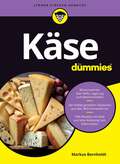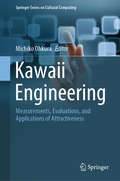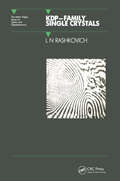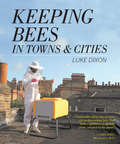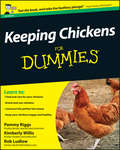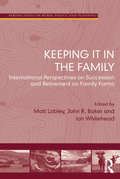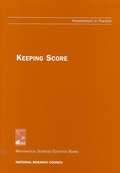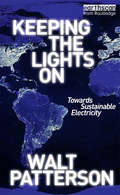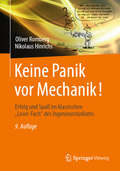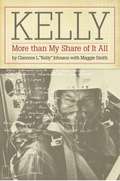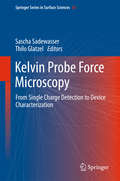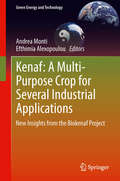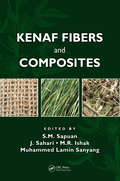- Table View
- List View
Karst without Boundaries (IAH - Selected Papers on Hydrogeology)
by Zoran Stevanović Neven KrešićKarstified rocks of different lithology cover more than 10% of the continental surface of our planet. It is known that some 20% or even a few percent more of the global population largely depends on karstic groundwater but in many karst areas all over the world there are limited natural resources including absence of drinking waters. The problems o
Käse für Dummies (Für Dummies)
by Markus BornholdtEgal, ob Sie lieber Weich- oder Hartkäse, Schweizer oder Französischen Käse genießen - in diesem Buch lernen Sie jede Menge neue Käsesorten aus aller Herren Länder kennen. Käsesommelier Markus Bornholdt plaudert aus dem Nähkästchen und würzt jede Käsesorte mit Anekdoten, geschichtlichen Hintergründen und Tipps, wie Sie diesen Käse am besten genießen. Außerdem erfahren Sie, wie Käse hergestellt wird, wie Sie selbst käsen und welche Lieblingsrezepte Ihnen der Autor ans Herz legt.
The Kat Bronsky Thrillers: The Last Hostage and Blackout (The Kat Bronsky Thrillers #1)
by John J. NanceTwo novels by a New York Times–bestselling author who can &“keep even the most experienced thriller addicts strapped into their seats for the whole flight&” (People). Featuring FBI hostage negotiator Kat Bronsky, these are two stories of pilots, passengers, and planes in peril that move at supersonic speed. The Last Hostage: When airline pilot Ken Wolfe learns that the presumptive nominee for US attorney general is on his flight, his blood runs cold. Rudolph Bostich bungled the case after Wolfe&’s daughter was kidnapped and killed—and let the perpetrator walk. Now Wolfe is prepared to do anything for revenge, including hijacking his own plane. It&’s up to FBI agent, psychologist, and rookie hostage negotiator Kat Bronsky to solve the mystery of an eleven-year-old girl&’s murder and save the lives of 130 terrified passengers. Blackout: A Boeing/McDonnell-Douglas MD-11 jetliner crashes into the Gulf of Mexico a mile inside Cuban waters, killing all onboard. The last three minutes on the plane&’s cockpit voice and data recorders have been erased. Was it a massive mechanical failure or an act of terrorism? When another airliner goes down after its pilots are flash-blinded midflight, Kat Bronsky races from the jungles of Southeast Asia to the forests of the American Northwest to unmask the conspirators before the entire American airline industry comes crashing out of the sky.
Katalog der Risiken: Risiken und ihre Darstellung
by Dirk ProskeDie Risikolehre bewertet basierend auf empirischen Daten die potenziell negativen Konsequenzen von Entwicklungen und Handlungen. Sie stellt einen wichtigen Bestandteil der Entscheidungstheorie dar. Neben der Quantifizierung der negativen Konsequenzen gibt die Risikolehre auch die Unsicherheit der Bewertung an. Das Buch beginnt deshalb mit der Diskussion der Begriffe Unbestimmtheit, Komplexität, Katastrophe, Sicherheit und Risiko. Im zweiten Kapitel werden Risiken in natürliche, technische, gesundheitliche und soziale Risiken eingeteilt und zahlreiche Beispiele vorgestellt. Im dritten Kapitel werden verschiedene Risikoparameter eingeführt. Dabei wird der Entwicklung von einfachen Risikoparametern zu komplexeren Parametern gefolgt. Im vierten Kapitel wird die subjektive Risikobewertung behandelt. Im fünften Kapitel werden Lebensqualitätsparameter als höchste Form der Risikoparameter erläutert. Dieser Parameter ermöglicht den eleganten Vergleich der Effizienz von Sicherheitsmaßnahmen. Abschließend werden kurz juristische Grundlagen der Risikobewertung umrissen und Anwendungsbeispiele der Lebensqualitätsparameter diskutiert. Das Buch umfasst eine große Zahl von Bildern und Tabellen, die die Zusammenhänge verdeutlichen sollen. Das Buch besitzt daher den Charakter eines Kataloges.
Kawaii Engineering: Measurements, Evaluations, and Applications of Attractiveness (Springer Series on Cultural Computing)
by Michiko Ohkura“Kawaii” is a Japanese word that denotes “cute,” “lovable,” or “charming” although it does not have exactly the same meaning as those adjectives. This book proposes engineering methodologies for systematic measurement of the affective perception of kawaii, by using virtual reality and biological signals, and discusses the effectiveness of kawaii engineering for designing industrial products and services. Kawaii can draw sympathy from people and can embody a special kind of cute design, which reduces fear and makes dull information more acceptable and appealing. Following the introduction of the background of kawaii engineering in Chapter 1, Chapters 2 and 3 describe experiments on the systematic measurement and evaluation methods for kawaii products and affective evaluation experiments. Chapter 4 proposes a mathematical model to identify the physical attributes that determine kawaii in motion. Chapters 5 and 6 explain research that uses biological signals and eye-tracking. After a brief survey of psychological research on kawaii and cuteness in Chapter 7, Chapters 8 and 9 introduce the use of spoons designed to stimulate the appetite of the elderly and the practical implementation of an emotion-driven camera. Chapters 10–14 explain experimental research that examines kawaii perception of people from various cultural backgrounds. Kawaii Engineering will appeal to those who work on affective computing, product design, user experience design, virtual reality, and biological signals.
KDP - Family Single Crystals (Series In Optics And Optoelectronics Ser.)
by L.N RashkovichThe KDP family of single crystals is composed of compounds of alkali metals with light or heavy (hydro, deutero) water and oxides of phosphate or arsenate, including ammonium, potassium, rubidium and caesium dihydro- and dideutero-phosphates, and similar arsenates. While not occurring in nature, their production exceeds that of any other water-soluble crystals and the demand for bigger and more optically pure crystals is ever increasing. KDP-Family Single Crystals is a comprehensive investigation of the crystallization mechanism for these systems. The first part of the book collects the majority of the available data on the physico-chemical analysis of these systems. This is complemented by a review of contemporary concepts related to the crystal growth dislocation mechanism under the influence of impurities, changing supersaturation, and temperature. This is not only relevant to the growth of KDP single crystals but to the majority of crystals grown from low- and high-temperature solutions. Finally, attention is given to the important problem of speeding up the production processes for the growth of these crystals while maintaining the quality of the crystals. The in-depth coverage that KDP-Family Single Crystals provides to the art of crystal growth techniques makes it an essential reference work for all those working in the field of crystal growth and to those using KDP-family crystals in quantum electronics devices.
Keep Chickens!: Tending Small Flocks in Cities, Suburbs, and Other Small Spaces
by Barbara KilarskiNo matter how small your lot is, you can keep chickens and enjoy fresh eggs every morning. Barbara Kilarski shares her passion for poultry as she fills this guide with tips and techniques for successfully raising chickens in small spaces. Spotlighting the self-sufficient pleasures of tending your own flock, Kilarski offers detailed information on everything from choosing breeds that thrive in tight quarters and building coops to providing medical care for sick animals. You’ll have fun as you keep happy and productive chickens.
Keep It Real (From the Files of Madison Finn #19)
by Laura DowerMadison is tired of all the secrets--why can't everyone just keep it real?Madison's not sure if her imagination is working overtime. Everyone--including her mom--is acting different! When Maddie checks out a new feature on TweenBlurt.com, she finds out her keypal, Bigwheels, has been keeping things from her. And then Hart sends a mean email about Madison--is he keeping secrets too?The truth is not always obvious, and Maddie isn't sure how to get the answers she wants. When her mom tells her a secret about Poison Ivy's family, Maddie knows it's serious news, and she's tempted to share it--especially when Ivy is acting mean. But some information is not ours to share . . .
Keeping a Family Cow: The Complete Guide for Home-Scale, Holistic Dairy Producers, 3rd Edition
by null Joann S. GrohmanThe cow is the most productive, efficient creature on earth. She will give you fresh milk, cream, butter, and cheese, build human health and happiness, and even turn a profit for homesteaders and small farmers who seek to offer her bounty to the local market or neighborhood. She will provide rich manure for your garden or land, and will enrich the quality of your life as you benefit from the resources of the natural world. Quite simply, the family that keeps a cow is a healthy family.Originally published in the early 1970s as The Cow Economy and reprinted many times over, Keeping a Family Cow has launched thousands of holistic small-scale dairy farmers and families raising healthy cows in accordance with their true nature. The book offers answers to frequently asked questions like, &‘Should I get a cow?&’ and &‘How Much Space do I need?&’ in addition to extensive information on:• The health benefits of untreated milk;• How to milk a cow effectively and with ease;• Choosing your dairy breed;• Drying off your cow;• Details on calving and breeding;• The importance of hay quality and how to properly feed your cow;• Fencing and pasture management;• Housing, water systems, and other supplies;• Treating milk fever and other diseases and disorders;• Making butter, yogurt, and cheese, and, of course . . .• . . . Everything else the conventional dairy industry doesn&’t tell us!Now revised and updated to incorporate new information on the raw milk debate, the conversation about A1 vs. A2 milk, fully grassfed dairies, more practical advice for everyday chores, and updated procedures for cow emergencies.Keeping a Family Cow has not only stood the test of time, it still remains the go-to inspirational manual for raising a family milk cow nearly forty years after its first publication. Joann Grohman has a lifetime of practical experience that has been bound into this one volume and presented in the spirit of fun and learning.
Keeping Bees in Towns and Cities
by Luke DixonKeeping Bees in Towns and Cities features everything an urbanite needs to know to start keeping bees: how to select the perfect hive, how to buy bees, how to care for a colony, how to harvest honey, and what to do in the winter. Urban beekeeping has particular challenges and needs, and this book highlights the challenges and presents practices that are safe, legal, and neighbor-friendly. The text is rounded out with profiles of urban beekeepers from all over the world, including public hives at the Maryland Center for Horticulture, beekeeping on an office balcony in Melbourne, Australia, and a poolside hive at a hotel in Vancouver, British Columbia.
Keeping Chickens For Dummies
by Pammy Riggs Kimberley Willis LudlowPractical how-to advice for keeping chickens "For me, raising chickens, for eggs and meat, has been one of the most enjoyable aspects of our family farm. I am a great admirer of "chicken whisperer" Pammy Riggs, and with her two co-authors she has produced an admirably thorough guide to enjoying the pleasures and avoiding the pitfalls of keeping chickens. Get the book, and take the feathery plunge!"- Hugh Fearnley-Whittingstall Keeping Chickens For Dummies provides you with an introduction to all aspects of keeping chickens, from constructing a hutch to the correct feeding regime. It offers expert advice straight from the River Cottage 'Chicken Whisperer', so whether you're looking to raise chickens for eggs, meat, or just the entertainment value and fun - Keeping Chickens For Dummies is the perfect place to start.Keeping Chickens For Dummies:Shows you how to keep chickens in different conditions Offers guidance on choosing and purchasing chickens Gives great step-by-step advice on constructing the right housing Provides expert advice on how to feed and care for your chickens
Keeping Cool in Southeast Asia
by Marlyne SahakianAgainst the backdrop of the environmental impact of household electricity consumption and the history of cooling practices, Marlyne Sahakian considers how people keep cool, from Metro Manila to other mega-cities in Southeast Asia.
Keeping Hope Alive: How One Somali Woman Changed 90,000 Lives
by Dr. Hawa AbdiFor the last twenty years, Dr Hawa Abdi and her daughters have run a refugee camp on their family farm not far from Mogadishu which has grown to shelter 90,000 displaced Somalis: men, women, and children in urgent need of medical attention. As Islamist militia groups have been battling for control of the country creating one of the most dire human rights crises in the world, Dr. Abdi's camp is a beacon of hope for the Somalis, most of whom have no proper access to health care. She was recently held hostage by a militant groups who threatened her life and told her that because she's a woman she has no right to run the camp. She refused to leave.This is not just the story of a woman doctor in a war torn Islamic country risking her life daily to minister to thousands of desperate people, it's also an inspiring story of a divorced woman and her two daughters, bound together on a mission to rehabilitate a country.
Keeping it in the Family: International Perspectives on Succession and Retirement on Family Farms (Perspectives On Rural Policy And Planning Ser.)
by Matt Lobley John R. Baker Ian WhiteheadAs the largest group of natural resource managers on the planet, farmers are at the interface of the changing relationship between humans and the environment. Typically organised around what might be considered the most basic of social units, for generations the family farm has survived wide-ranging exogenous challenges, frequently preserving the line of succession to the next of kin. Now as we face major questions about how we use land and the impact of our land use on the global environment, farming once again faces a challenging and uncertain future. This book draws on the experiences of farmers in Australia, New Zealand, North America, Japan and the EU to examine the special features of family farms and, in particular, the tradition of succession which has enabled them to continue to have such a strong presence in the world today.
Keeping Patients Safe: Transforming the Work Environment of Nurses
by Institute of Medicine of the National AcademiesBuilding on the revolutionary Institute of Medicine reports To Err is Human and Crossing the Quality Chasm, Keeping Patients Safe lays out guidelines for improving patient safety by changing nurses working conditions and demands. Licensed nurses and unlicensed nursing assistants are critical participants in our national effort to protect patients from health care errors. The nature of the activities nurses typically perform – monitoring patients, educating home caretakers, performing treatments, and rescuing patients who are in crisis - provides an indispensable resource in detecting and remedying error-producing defects in the U.S. health care system. During the past two decades, substantial changes have been made in the organization and delivery of health care - and consequently in the job description and work environment of nurses. As patients are increasingly cared for as outpatients, nurses in hospitals and nursing homes deal with greater severity of illness. Problems in management practices, employee deployment, work and workspace design, and the basic safety culture of health care organizations place patients at further risk. This newest edition in the groundbreaking Institute of Medicine Quality Chasm series discusses the key aspects of the work environment for nurses and reviews the potential improvements in working conditions that are likely to have an impact on patient safety.
Keeping Score: Assessment in Practice
by Ann ShannonKeeping Score is a brief and well organized consideration of effective authentic assessment.-- Teacher Education Materials Project online
Keeping the Lights On: Towards Sustainable Electricity
by Walt Patterson�This is such a timely book. Combining extraordinary historical insight with the sharpest analysis of where we are now, Walt Patterson carves out the most applied and practical of 'road maps' as to where we need to go if we are to deliver a genuinely sustainable electricity system for the future. As we go into a period of considerable turbulence, primarily because of the impacts of climate change, Keeping The Lights On will undoubtedly be seen as a very well informed Guidebook.� JONATHON PORRITT CBE, CHAIR, UK SUSTAINABLE DEVELOPMENT COMMISSION �A very important and timely book. Walt Patterson persuasively challenges traditional assumptions about how we think of energy and electricity, and presents an exciting vision of an innovative and sustainable future.� NICK MABEY, CHIEF EXECUTIVE, E3G (THIRD GENERATION ENVIRONMENTALISM), FORMER SENIOR ADVISER IN THE UK PRIME MINISTER�S STRATEGY UNIT �Walt has got this exactly right. It should be compulsive reading, if not compulsory reading, for all politicians and other players that determine or have a role to play in energy policy and, more importantly, in tackling climate change. Knowing what we know now, you would not implement such a wasteful and polluting electricity system as centralized power generation. As Walt has indicated, we do have to overcome the grid mindset of those who should know better.� ALLAN JONES MBE, CHIEF EXECUTIVE OFFICER, LONDON CLIMATE CHANGE AGENCY �What can I say? Clearly thought out, simply written, and straight to the heart of the major issues in energy today. I can�t think of anyone else who could bring together the technology, the economics, and the basic human relationship with energy that Walt has here. This is really great stuff.� RONAN PALMER, CHIEF ECONOMIST, UK ENVIRONMENT AGENCY �Fashions come and fashions go in the energy world. Security of supply, climate change and market liberalization have all vied for our attention. It�s good to have one voice that�s stayed constant over thirty years of turbulence and change. Keeping The Lights On distils Walt Patterson�s thinking over the last three decades. As ever, he provokes us to re-examine our own thinking about energy policy. Essential reading as we face up to new challenges.� PROFESSOR JIM SKEA OBE, RESEARCH DIRECTOR, UK ENERGY RESEARCH CENTRE 'Even more important now than when first released.' Energy News In Keeping The Lights On, Walt Patterson starts from a simple premise: that we are making a mess of energy, and this is endangering the planet. Using accessible, everyday language Patterson describes how we could do much better, outlining a different way to think about energy, what we want from it and how we get it. Drawing on over 35 years of work from one of the leading voices in the field, Keeping The Lights On explains how we could go about improving energy security and services while reducing costs and vulnerability, globally and rapidly. The book discusses the timely and heated debates surrounding energy and power, and emphasizes that electricity is about infrastructure; we have to stop treating it as a commodity. The result is a comprehensive introduction to the most important issues, providing the reader with innovative and expert ideas and solutions. Published with Royal Institute of International Affairs.
Keeping Track
by Amy TaoDid you know that scientists can track animals? By tracking animals, scientists can see where animals migrate to and from. These trackers can be big or small and are different depending on the kind of animal being tracked. Learn about the different technology that is used for tracking!
The Kefaya Movement
by Nadia Oweidat Walid Kildani Cheryl Benard Dale Stahl Edward O'ConnellKefaya was an indigenous movement for political reform organized in late2004 in opposition to the regime of Egyptian President Hosni Mubarak. Thisexamination of Kefaya's birth, accomplishments, and decline is based on ananalysis of the work of Egyptian scholars and Arabic-language media reports(including online and new media), as well as structured interviews withpersons associated with and observers of Kefaya and the Muslim Brotherhood.
Keine Panik vor Mechanik!: Erfolg und Spaß im klassischen "Loser-Fach" des Ingenieurstudiums
by Oliver Romberg Nikolaus HinrichsDer Begleiter durch das klassische "Loserfach" im Ingenieurstudium. Inhalt des Buches sind die Grundlagen der Mechanik, wie sie im ingenieurwissenschaftlichen Grundstudium behandelt werden, also Statik, Festigkeitslehre, Kinematik und Kinetik, in unkonventioneller, humorvoller Darstellung mit 300 Cartoons und Zeichnungen sowie 99 Übungsaufgaben mit ausführlichen Lösungen. Nach dem Motto: "Schluss mit dem Prüfungsdurchfall!" bleibt trotz der lockeren Darstellungsweise die Korrektheit des Inhalts nicht auf der Strecke.
Kelly: More Than My Share of It All
by Clarence L. JohnsonClarence L. "Kelly" Johnson led the design of such crucial aircraft as the P-38 and Constellation, but he will be more remembered for the U-2 and SR-71 spy planes. His extraordinary leadership of the Lockheed "Skunk Works" cemented his reputation as a legendary figure in American aerospace management.From the Trade Paperback edition.
Kelvin Probe Force Microscopy: Measuring And Compensating Electrostatic Forces (Springer Series in Surface Sciences #48)
by Sascha Sadewasser Thilo GlatzelThis book provides a comprehensive introduction to the methods and variety of Kelvin probe force microscopy, including technical details. It also offers an overview of the recent developments and numerous applications, ranging from semiconductor materials, nanostructures and devices to sub-molecular and atomic scale electrostatics.In the last 25 years, Kelvin probe force microscopy has developed from a specialized technique applied by a few scanning probe microscopy experts into a tool used by numerous research and development groups around the globe. This sequel to the editors’ previous volume “Kelvin Probe Force Microscopy: Measuring and Compensating Electrostatic Forces,” presents new and complementary topics.It is intended for a broad readership, from undergraduate students to lab technicians and scanning probe microscopy experts who are new to the field.
Kenaf: A Multi-Purpose Crop for Several Industrial Applications
by Efthimia Alexopoulou Andrea MontiNatural plant fibers fibres are being increasingly used in manufacturing industrial products because of their renewable and biodegradable natures. Kenaf is an annual bast fibre crop that can provide fibres for several industrial applications (composites, insulation mats, absorbents, bedding material, etc.) as well as raw material for energy exploitation (solid biofuels). Kenaf: A Multi-Purpose Crop for Several Industrial Applications introduces the physiology and field management of kenaf, agronomy, productivity, harvesting as well as its the industrial and energy uses of this promising non-food crop. Including recent research collected by the BIOKENAF project, Kenaf: A Multi-Purpose Crop for Several Industrial Applications provides a global picture of state of the art research and developments with Kenaf from Asia, USA and Australia. This thorough introduction if followed up with an assessment of the crops economic viability as well as an the environmental impact assessment of kenaf. Although not a new crop, Kenaf: A Multi-Purpose Crop for Several Industrial Applications provides a comprehensive introduction to this crop and its developing applications for energy engineers, industry managers, politicians and managers working to develop sustainable energy sources and bio-economies.
Kenaf Fibers and Composites
by S. M. Sapuan M. R. Ishak J. Sahari Muhammed Lamin SanyangKenaf fiber is gaining attention as an alternative reinforcement for composite products due to low cost, reduced environmental impact, and attractive mechanical properties. Kenaf Fibers and Composites covers the breadth of these exciting materials, from raw material preparation to application in a variety of products. It discusses fiber characterization and properties, how to prepare kenaf-based composites, and design, manufacturing, and applications. It also covers hybrid fiber composites, kenaf fiber thermosetting composites, kenaf fiber thermoplastic composites, kenaf fibers in various lengths, and forms and arrangements such as particulates, continuous roving, and woven fabrics. Cellulose-based kenaf composites and kenaf fiber-filled biopolymer composites are presented.
Kennzahlen zur Erreichung der weltweiten Klimaziele: Band II: Amerika, Nahost und Südasien, Ostasien und Ozeanien
by Valentin CrastanAnalysiert werden die aktuellen Kennzahlen aus der Energiewirtschaft für die geographischen Einheiten Amerika – unterteilt in Nordamerika (Kanada + USA) sowie Mittel- und Südamerika –, Nahost und Südasien sowie Ostasien und Ozeanien. Die wichtigsten energiewirtschaftlichen Indikatoren der einzelnen Regionen und Länder und deren Entwicklung werden in zahlreichen Grafiken und Energieflussdiagrammen veranschaulicht. Darauf basierend empfiehlt der Autor eine Verteilung der zur Begrenzung des Klimawandels notwendigen Emissionsreduktion (für Klimaziel 2 °C und 1,5 °C, mit Perspektive bis 2050).Die in diesem Band behandelten Erdteile verursachen zusammen 77 % der Emissionen. Europa + Eurasien sowie Afrika werden in einem weiteren Band behandelt.

